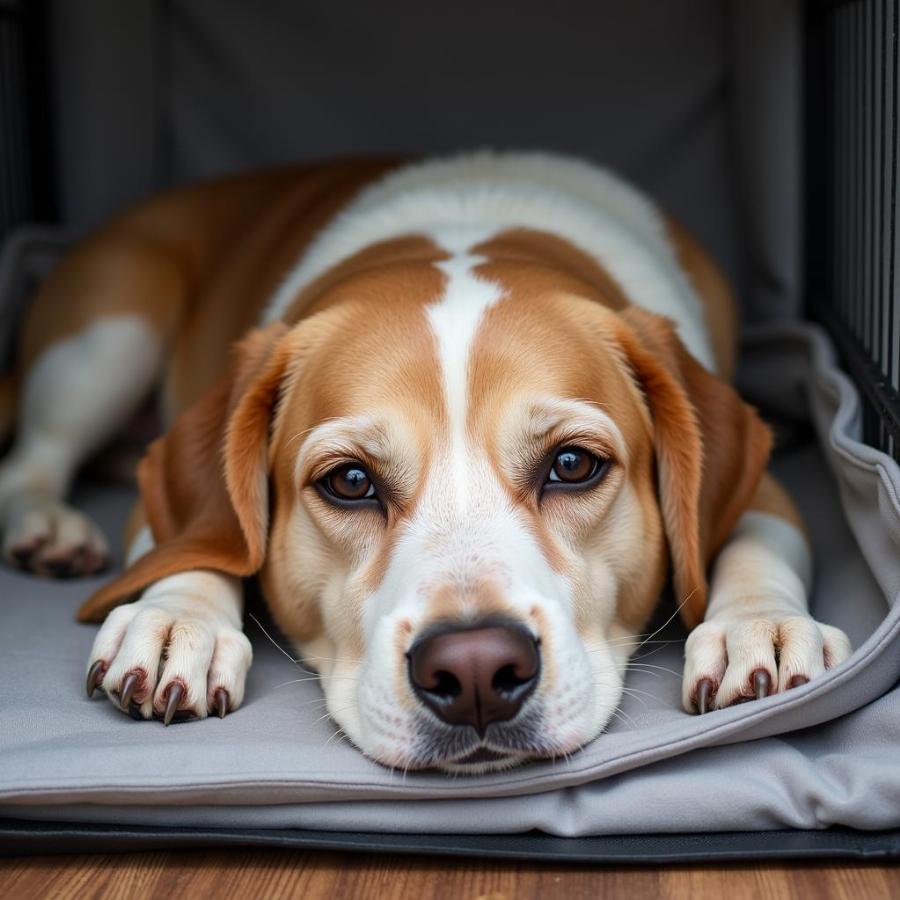A dog crate can be a haven for some dogs, a place of comfort and security. However, for dogs with high anxiety, the crate can sometimes exacerbate their fears, creating a negative association. Understanding the impact of high anxiety on a dog’s experience in a crate is crucial for owners who want to use crate training effectively and humanely. This article will delve into the relationship between high anxiety and crate training, exploring why some dogs struggle with confinement and providing practical solutions to help anxious dogs feel safe and comfortable in their crates.
Why Does My Dog’s Anxiety Increase in a Crate?
Several factors can contribute to a dog’s anxiety within a crate. Confinement itself can trigger anxiety, especially if the dog has a history of abandonment or isolation. Past negative experiences with crates, such as being punished or left alone for extended periods, can also create a negative association. Furthermore, underlying anxiety disorders, like separation anxiety or noise phobias, can manifest more intensely in the confined space of a crate. If your dog exhibits panting, pacing, whining, barking, or destructive behaviors within the crate, it could indicate high anxiety.
Creating a Positive Crate Experience for Anxious Dogs
Turning the crate into a positive space requires patience, understanding, and a gradual approach. Start by introducing the crate slowly, allowing the dog to explore it on their own terms. Place treats and toys inside to encourage positive associations. Never force the dog into the crate. Feed meals near or inside the crate. Short, supervised crate training sessions are key, gradually increasing the duration as the dog becomes more comfortable.
Managing Anxiety Triggers: Addressing Underlying Issues
Sometimes, the crate itself isn’t the problem, but rather a magnifying glass for underlying anxiety. Identifying and managing these triggers is crucial. If separation anxiety is the root cause, desensitization training and counter-conditioning can help. For noise phobias, creating a quiet and calming environment within the crate can be beneficial. Consulting with a veterinarian or a certified professional dog trainer can provide personalized guidance and support. They can help develop a tailored behavior modification plan that addresses the dog’s specific needs.
Signs of High Anxiety in a Crated Dog: What to Look For
Recognizing the signs of high anxiety in a crated dog is essential for early intervention. Excessive panting, whining, barking, destructive chewing on the crate bars, and attempts to escape are all red flags. Trembling, urination, or defecation inside the crate despite being house-trained are also indicators of extreme distress. If your dog displays any of these behaviors, it’s crucial to address the underlying anxiety rather than forcing continued crate confinement.
When to Seek Professional Help
While many anxiety issues can be managed with at-home training, sometimes professional help is necessary. If your dog’s anxiety is severe, persistent, or impacting their overall well-being, consult a veterinarian or a certified applied animal behaviorist. They can offer specialized guidance and develop a comprehensive treatment plan, potentially including medication or behavior modification techniques.
 Comfortable dog in a crate
Comfortable dog in a crate
Conclusion
The impact of high anxiety on a dog’s crate experience can be significant, but with patience and understanding, a crate can become a safe haven. By addressing underlying anxiety triggers, creating positive associations with the crate, and seeking professional guidance when needed, we can help our anxious companions find comfort and security in their crates. Remember, impact dog crate high anxiety is a real issue, and understanding its nuances is key to a successful crate training journey. Addressing impact high anxiety dog crate situations effectively requires a compassionate and informed approach.
FAQ
-
Can I use a crate for a dog with separation anxiety? Yes, but it needs to be introduced gradually and positively, focusing on building positive associations with the crate.
-
What if my dog continues to panic in the crate? Don’t force it. Seek professional guidance from a veterinarian or certified trainer.
-
Are there alternatives to crate training for anxious dogs? Yes, xl dog crate cover can be used, and creating a safe space with dog beds and familiar toys can be helpful.
-
How long should I leave my anxious dog in the crate? Start with very short durations and gradually increase the time as the dog becomes more comfortable.
-
Can medication help with crate anxiety? In some cases, medication may be necessary in conjunction with behavior modification. Consult your veterinarian.
-
How can I make the crate more comfortable for my dog? Use soft bedding, provide toys, and cover the crate partially to create a den-like feeling.
-
Is it cruel to crate an anxious dog? Not if done correctly. A properly introduced and managed crate can provide security and comfort for some anxious dogs. It’s important to remember that each dog is unique, and not all will benefit from crating, especially those experiencing high levels of anxiety.
Have you considered these topics?
Are you interested in learning more about dog supplies? Check out our article on double u dog supply. Thinking of getting a Golden Retriever? Explore the ease of owning one with our article, is golden retriver easy to have in dog.
Beaut Dogs: Your Guide to the Canine World
Beaut Dogs is your one-stop resource for all things dog-related, providing reliable, helpful, and in-depth information about the world of canines. From breed characteristics and care guides to expert advice on training and nutrition, we’re here to help you navigate the joys and challenges of dog ownership. When you need assistance, reach out to us via Email: [email protected] to receive detailed and accurate answers from Beaut Dogs. Visit https://beautdogs.com today to delve deeper into the wonderful world of dogs.